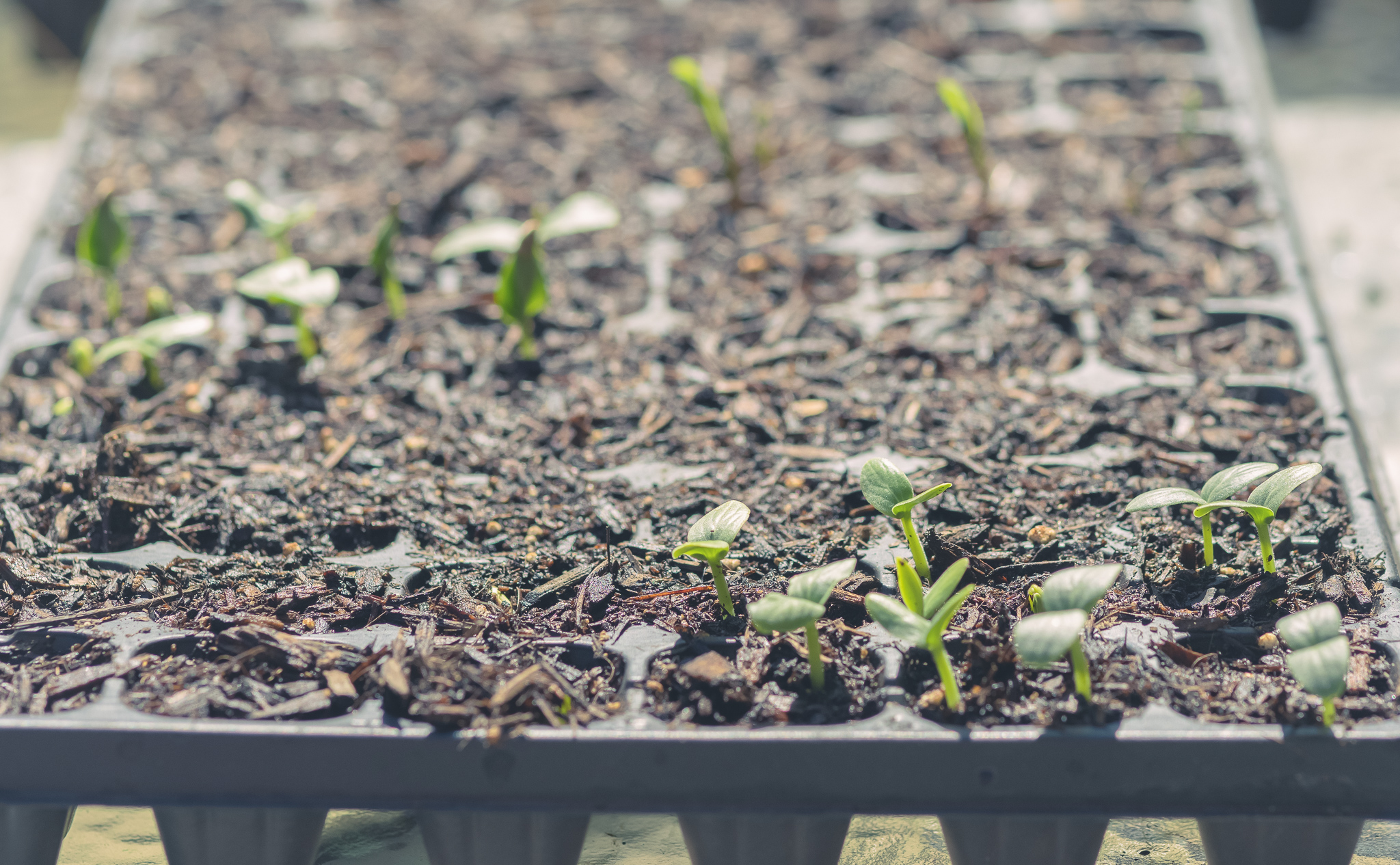Let’s get the obvious out of the way first: you can absolutely buy vegetable plants from the store and replant them. It’s a pretty fast way to start growing food. But… you should 100% start with seeds instead. Planting seeds is a wildly cheaper proposition that will actually scale up with your interest, whereas buying seedlings will quickly add up to a small fortune. Plus, the satisfaction of successfully popping a seedling out of the dirt is just unreal.
So give seeds a shot and allow yourself to get addicted to growing your own food!
Fortunately, it’s incredibly simple to start seeds indoors. Here are the basic steps.
1. MOISTEN YOUR POTTING SOIL
Pour potting soil from a bag into a large container and get it moist, not wet! Why from a bag, you ask? Because you want your soil to be relatively sterile and you don’t need very much.
You can find bags of seed starter mix specifically designed for this purpose. It works great, but my general philosophy is seeds are cheap and bagged soil is not so I don’t bother.
2. FILL SEED TRAYS WITH POTTING SOIL
Leave space between the top line of soil and the lip of the plastic cell to make adding a shallow layer of soil over the seeds less messy.
3. LABEL EACH SEED CELL
Use tape, popsicle sticks, strips of cardboard, or anything else handy. Trust me when I say this is a necessary step; you don’t want to forget what’s what as many seedlings look eerily similar. Just don’t buy those expensive gardening labels!
If you’re feeling too lazy to make DIY labels (no judgement), whip out your phone and record a video documenting yourself describing what’s in each section of the tray instead.
4. LAY SEEDS ON SOIL
Add at least two seeds to each cell for redundancy (accounting for seeds that don’t germinate). Don’t overdo it with many seeds per cell though, unless you know ahead of time that your yours will have a poor germination rate for some reason. I’m more often surprised at how many seeds do germinate than the reverse.
5. COVER SEEDS WITH SOIL
Cover the seeds carefully with soil according to the instructions on the back of the seed packet. Surprisingly, this step is the easiest to go astray because seed depth really does matter - particularly for certain seeds that require light to germinate.
6. WATER SEEDLING TRAYS
Water generously, preferably by slowly adding water to a flat tray with a lip placed under the seed tray. This “bottom up” watering method more evenly wets the cells and doesn’t tear up the top layer of dirt where small, vulnerable seeds lie. That said, gentle watering from above works fine (you’ll still need something to keep the water from running out the bottom).
Going forward, you’ll repeat this step whenever the top layer of soil has fully dried and turned a distinctly lighter brown color.
CARE FOR INDOOR VEGETABLE SEEDS
Germination times differ plant to plant but you can usually expect life to appear from the dirt within a week. From that point on, your number one goal is to maximize the light your plants receive. Seedlings that don’t receive enough light grow long and thin - often referred to as “leggy”.
Assuming this is a first foray into starting seeds indoors, you’ll probably rely on sunlight rather than purchasing specialty grow lights so be sure to scout out the window with the strongest and most sustained light in your home and plop your trays in front of it. Give it clean too for maximum light!
If your home is super chilly, consider purchasing a seedling mat to provide even warmth. I’d recommend trying without one first and then evaluating if you need it for future rounds.
CARE FOR INDOOR VEGETABLE SEEDLINGS
The first set of leaves on your adorable baby plants are actually not leaves at all. Known as cotyledon, these “false leaves” contain a store of nutrients for the growing shoot. Once the next set of leaves come in, they’ll be immediately distinguishable from the cotyledon.
Soon, it will be time to steel yourself to begin culling the weakest plants in each cell, leaving only the strongest. You can identify the strongest plants around the time the second set of true leaves appear (don’t count the cotyledon). While culling is never fun, it is necessary and you’ll probably regret not doing it while the plants are still small with weak roots.
If you really can’t bring yourself to leave only one plant per cell, you can carefully separate them with a knife or your fingers and transplant the individual seedlings.
Once your seedlings have 2-3 sets of true leaves, you need to start the “hardening off” process if you plan to move them outside eventually. Hardening off is just a fancy term for giving your young seedlings progressively more time outdoors each day so they can become accustomed and resilient to things like direct sunlight, temperature changes, and wind.
And that’s it! If this all seems too easy, that’s a fair sentiment. There are many, many steps you can add in to optimize for success, ranging from a cheap heating mat to a greenhouse set up for perfect conditions. But the truth is, if you haven’t grown a lot of edible plants from seed yet, those optimizations will make the process many times more complicated and expensive but not many times more effective. So start simple and go bigger when you feel it’s worth the investments.
Happy planting!
